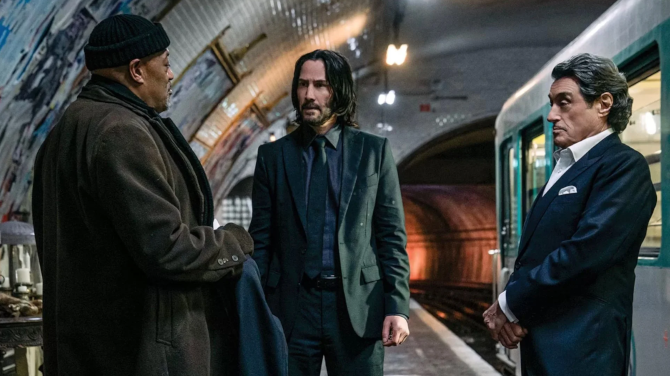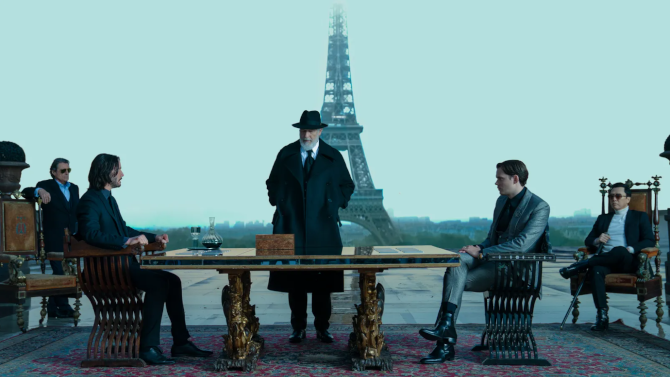Covering some new and old ground in the longest feature of the franchise (coming in at a whopping two hours and forty-nine minutes), John Wick: Chapter 4, directed by Chad Stahelski (who has helmed each of the four films), starts us off pretty much right after the previous picture.
Flipping the script a bit from the last one, Wick (Keanu Reeves), now healed (boy, does he do that quickly – though it’s supposed to be a couple months later), must deal with the claustrophobic landscape that has enveloped him due to his unsatiated revenge-filled drive. Walking the perilous path of dealing with hitmen, as well as friends and enemies (who can often switch allegiances on a dime), the memorable faces of the underground web weaver – the Bowery King (Laurence Fishburne), New York powerhouse – Winston (Ian McShane), his trusty concierge – Charon (Lance Reddick, who sadly passed away on March 17th), and the head of the table – Elder (George Georgiou), will all make appearances again. . . though perhaps not in the ways we might expect.
Taking the story in a somewhat unforeseen direction, the first half of the film expounds more plot than perhaps ever before, introducing the viewer to a new baddie, the Marquis (Bill Skarsgård), a sacred member of the High Table, the Harbinger (Clancy Brown), a seemingly retired blind assassin who has a surprisingly positive past with Wick, Caine (Donnie Yen), and a very close friend of Wick’s, the Osaka Continental manager, Shimazu (Hiroyuki Sanada – his performance will harken us back to a year ago, when he played the somewhat similar Elder in Bullet Train). There is also a Mr. Nobody (Shamier Anderson), a dog loving tracker who will help Wick stay alive until the bounty on his head is high enough. . . at which point he will turn his skills on the disgraced Boogeyman for the payday.
Dealing with past and present, Wick jumps from New York, to heated desert, eventually finding himself in Japan. Though important to the story and visually impressive like the rest of the franchise, this might be the most disinterested fans will get – as it feels rather repetitive, echoing the climactic fight sequences seen in the New York Continental at the end of Part 3. Also note that there is an end credit scene that will provide at least one answer that was left open from this segment.
Things truly become inspired a little over halfway through, when our protagonist makes his way to Germany. Providing some more family background – we meet his cousin Katia (Natalia Tena), but also the much more menacing Killa (Scott Adkins – in a fatsuit). . . a giddy, gold toothed German gambler, things get funny and frenetic in a packed multi-level nightclub.
This energy pushes through to the conclusion (now in Paris), with a High Table radio station spinning different tracks as countless killers try to stop the unstoppable on his way to the final finale. Unused subway stations, cars, buildings, staircases, and so much more come into play, all backed by this unique soundtrack. Perhaps the coolest visuals come when they enter a Parisian household, the camera panning overhead as new flaming bullets from shotguns are used. This God-like perspective shows off different flooring (from normal hardwood to stunning herringbone), but more importantly, we see multiple rooms and people as the flashing light of the ammo adds cinematography to the empty and unlit abode. Pure cinema magic.
And speaking of lighting, the cinematography and locations outdo all of the previous efforts combined. The settings feel real, from the city streets of Paris (the Eiffel Tower and Arc de Triomphe on full display) and churches of the world, to the flowering sakura trees of Japan and multi-dimensional German nightclub (inspired by the Berghain), there has never been more beauty and class. In many ways, you might expect to see these locations in a vibrant video game, but never in real life.
Another worthy entry in the action franchise, John Wick: Chapter 4 further adds to the debate over which is best. There is no doubt the original had almost no fat – fresh, lean and direct with its action and story – with excellent villains. The second felt a bit more cartoonish, and is often placed at the bottom of the list. . . though it is still highly entertaining. There is little argument that the third has the best beginning – a shot of adrenaline and dark comedy that has yet to be surpassed, while this edition has arguably the best conclusion (and by that I mean more than an hour’s worth). What cannot be debated is that it is another impressive addition. . . and deserves to be a part of this discussion. So, watch as Wick travels the four winds, and find out if he can keep the fuse lit.




